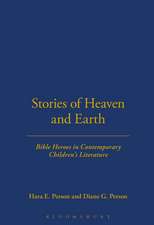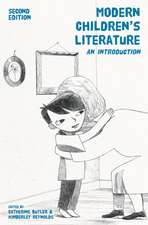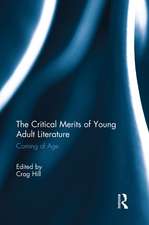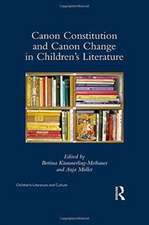Adapting Canonical Texts in Children's Literature
Editat de Prof. Dr. Anja Mülleren Limba Engleză Paperback – 16 iul 2014
| Toate formatele și edițiile | Preț | Express |
|---|---|---|
| Paperback (1) | 257.32 lei 6-8 săpt. | |
| Bloomsbury Publishing – 16 iul 2014 | 257.32 lei 6-8 săpt. | |
| Hardback (1) | 773.81 lei 6-8 săpt. | |
| Bloomsbury Publishing – 16 ian 2013 | 773.81 lei 6-8 săpt. |
Preț: 257.32 lei
Preț vechi: 331.09 lei
-22% Nou
Puncte Express: 386
Preț estimativ în valută:
49.25€ • 51.22$ • 41.27£
49.25€ • 51.22$ • 41.27£
Carte tipărită la comandă
Livrare economică 13-27 martie
Preluare comenzi: 021 569.72.76
Specificații
ISBN-13: 9781472578884
ISBN-10: 1472578880
Pagini: 256
Ilustrații: 8 illus
Dimensiuni: 156 x 234 x 13 mm
Greutate: 0.35 kg
Editura: Bloomsbury Publishing
Colecția Bloomsbury Academic
Locul publicării:London, United Kingdom
ISBN-10: 1472578880
Pagini: 256
Ilustrații: 8 illus
Dimensiuni: 156 x 234 x 13 mm
Greutate: 0.35 kg
Editura: Bloomsbury Publishing
Colecția Bloomsbury Academic
Locul publicării:London, United Kingdom
Caracteristici
Analysis
of
age-specific
adaptation
of
interest
to
both
children's
literature
and
adaptation
scholars
Notă biografică
Anja
Müller
is
Professor
of
English
Literature
and
Culture
at
the
University
of
Siegen,
Germany.
Her
publications
includeFashioning
Childhood
in
the
Eighteenth
Century(2006)
andFraming
Childhood
in
Eighteenth-Century
English
Periodicals
and
Prints,
1689-1789(2009)
which
was
designated
the
Honor
Book
2009
of
the
Children's
Literature
Association.
Cuprins
Introduction1.
Shakespeare
for
Girls:
Victorian
vs.
Contemporary
Prose
Versions
of
Hamlet
and
The
Merchant
of
Venice,Laura
Tosi,
Ca'
Foscari,
Venice,
Italy2.
Shylock's
Daughter,
Nathan
and
his
Children,
Golem
Silent
Brother
-
Adapting
European
Classics
in
the
Work
of
Miriam
Pressler,Jana
Mikota,
Universität
Siegen,
Germany3.
Shakespeare
in
Children's
Literature:
Susan
Cooper's
King
of
the
Shadows
and
Tad
Williams's
Caliban's
Hour,Eva
Oppermann,
Universität
Kassel,
Germany4.
Shakespeare
for
Beginners:
The
Animated
Tales
from
Shakespeare
and
the
Case
Study
of
Julias
Ceasar
,Maddalena
Pennacchia,
Roma
Tre
University5.
Adapting
and
Parodying
Shakespeare
for
Young
Adults:
John
Marsden's
Hamlet
and
Andy
Griffth's
Just
Macbeth!,Mark
MacLeod,
Charles
Sturt
University,
Wagga
Wagga
Campus,
Australia6.
Shakespeare
Comic
Books
-
Adapting
the
Bard
for
a
Young
Audience,Anja
Müller,
Universität
Siegen,
Germany7.
Rosemary
Sutcliffe's
Beowulf:
DragonslayerLukascz
Neubauer,
Technical
University
of
Koszalin,
Poland8.
The
Kids
of
the
Round
Table:
Arthurian
Traces
in
Fantasy
Fiction
for
Children
and
Young
AdultsAnne
Klaus,
University
of
Osnabrück,
Germany9.
Downsizing
Dickens:
Adaptations
of
Oliver
Twist
for
the
Child
Reader,Elizabeth
Thiel,
University
of
Roehampton,
UK10.
Pinocchio
in
English,Iain
Halliday,
Universita
di
Catania11.
The
Adaptation
of
a
Children's
Story
which
has
Adult
Messages:
The
Nutcracker
from
E.T.A.
Hoffmann
to
Matthew
Bourne,Janice
Keane,
University
of
Nottingham,
UK12.
To
Be
Or
Not
To
Be
A
Canonical
Text
of
Children's
Literature:
Polish
and
Italian
Translations
of
Winnie-the-Pooh,Monika
Wozniak,
Universita
La
Sapienza
di
Roma,
Italy13.
Disney(Never)land's
Tinker
Bell,Lisa
Rowe
Fraustino,
Eastern
Connecticut
State
University,
USAReferences
Index
Recenzii
By
introducing
a
wide-ranging
set
of
case
studies,
from
multi-media
versions
of
plays
by
Shakespeare
to
cross-cultural
reinterpretations
of
classic
tales,
this
volume
places
a
welcome
emphasis
on
international
research
into
adaptations
for
children.
Transitions
from
the
adult
to
the
children's
canon,
from
one
language
to
another
and
from
page
to
feature
film,
animation,
comic
strip
or
dance
are
all
examined
with
scholarly
attention
to
the
aesthetic
and
ideological
issues
that
arise
in
the
course
of
adaptation.
Anja
Müller
has
succeeded
in
drawing
together
a
lively
and
informative
series
of
insights
into
the
transcultural
reach
of
adaptation
strategies
for
the
child
reader
or
viewer.
Featuring an impressive set of renowned international scholars, this collection combines rigorous theory with fascinating reader-friendly analysis of individual texts, that goes far beyond case studies. Positioned within the rapidly expanding field of adaptation theory, it targets a wide audience and punctures common misconceptions about children's literature and its role in society and education. A timely and welcome volume.
Adapting Canonical Texts in Children's Literatureis a benchmark contribution that challenges the reader to reconsider the status of canonicity and adaptation within the realm of children's literature. Covering a huge historical range and addressing key topics in research and criticism, such as genre-crossing, intermediality, and intercultural studies, the essays combine illuminative close readings with a broad theoretical astuteness.
The topic of this book, edited by Anja Muller, concerns adaptations for children and young adult readers of adult canonical texts ("The Merchant of Venice", "Hamlet", "The Tempest", "A Midsummer Night's Dream", "Julius Caesar", "Macbeth", but also "Beowulf" and "Le Morte d'Arthur"), of children's classics ("Winnie-the-Pooh"),and of novels ("Oliver Twist", "Pinocchio" and "The Nutcracker") that can be regarded as canonical both for adult and child readers. It shows how adaptations can question the very notion of canons and classics of children's literature and it presents us with a variety of positions with regard to the approach to adaptation. It certainly gives food for thought.
Featuring an impressive set of renowned international scholars, this collection combines rigorous theory with fascinating reader-friendly analysis of individual texts, that goes far beyond case studies. Positioned within the rapidly expanding field of adaptation theory, it targets a wide audience and punctures common misconceptions about children's literature and its role in society and education. A timely and welcome volume.
Adapting Canonical Texts in Children's Literatureis a benchmark contribution that challenges the reader to reconsider the status of canonicity and adaptation within the realm of children's literature. Covering a huge historical range and addressing key topics in research and criticism, such as genre-crossing, intermediality, and intercultural studies, the essays combine illuminative close readings with a broad theoretical astuteness.
The topic of this book, edited by Anja Muller, concerns adaptations for children and young adult readers of adult canonical texts ("The Merchant of Venice", "Hamlet", "The Tempest", "A Midsummer Night's Dream", "Julius Caesar", "Macbeth", but also "Beowulf" and "Le Morte d'Arthur"), of children's classics ("Winnie-the-Pooh"),and of novels ("Oliver Twist", "Pinocchio" and "The Nutcracker") that can be regarded as canonical both for adult and child readers. It shows how adaptations can question the very notion of canons and classics of children's literature and it presents us with a variety of positions with regard to the approach to adaptation. It certainly gives food for thought.
















